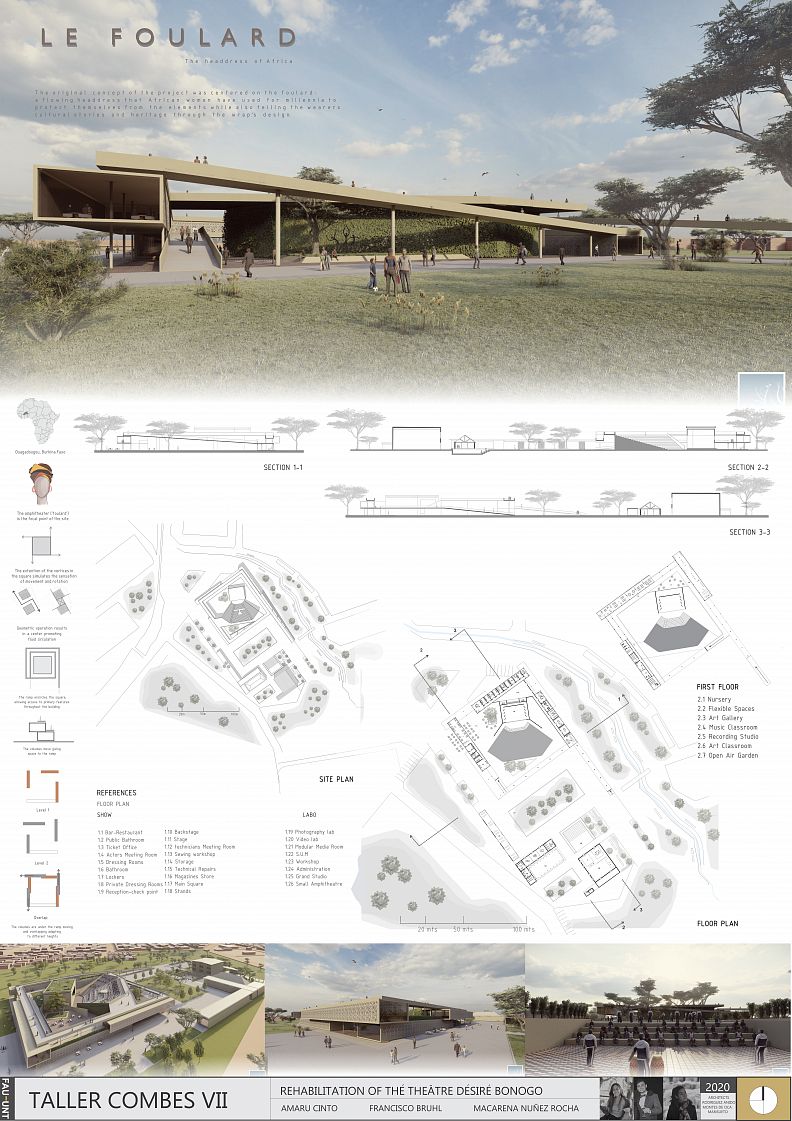Le Foulard

Project idea
The central concept of our project is based on the traditional female headdress of Burkina Faso, the Foulard. This accessory does more than simply make for good aesthetics; it is a powerful symbol of the African history and resilience.
This iconic, flowing wrap is known by different names throughout the African continent. As it crosses borders, the significance woven into the patterns adorning the fabric also change, to represent the heritage and traditions of the wearer. Our intent was to create a foulard for the people of Bonogo; a flowing cultural space designed to represent and to tell their story, both in form and in function.
Based on this abstract interpretation of the foulard, we begin our examination of this idea with the most basic function of the foulard: a means of protection against the elements for African women and their hair and skin. To mirror this protection, we decided to protect the structure using local techniques, such as the pitch and elevation of roofing components that aid ventilation to lower ambient internal temperatures, acting as a natural air conditioning system.
The foulard also represents a feeling of union and belonging among women. Accordingly, we seek to link the amphitheater with the local urban scale and with the surrounding environment.
Another core tenant intertwined between the foulard and the amphitheater is security. Historically, women braided their hair into maps, detailing escape routes into their braids. The foulard hid these ‘hair maps’, allowing the women to protect themselves and those around them. Similarly, the amphitheater creates a sense of security, with the main ramp woven through the structure to allow ease of access to all of the primary features of the structure in a coherent and easy to follow pathway.
The heritage of tying the foulard is a sacred art, passed down from mother to daughter. This instruction marks a transmission of heritage and culture through the generations. As a social performance space, the amphitheater echoes this transmission of local heritage. The amphitheater is a place of critical importance for the survival of the local culture, in the same way the tying of the foulard is.
Finally, the foulard acts as a communication device. According to the weave of the foulard, the woman who ties it can communicate a message or important news item. Similarly, we have ‘weaved’ the amphitheaters exterior with open façades to all directions, opening up the space to the community, promoting ease of access to the performances (and the messages of the performances).
Project description
Our project’s site plan is arranged around a geometric square placed in the center, and the extension of the square’s vertices generates two other squares, and the sensation of rotation and movement throughout the site.
This separation of the two squares creates a center that becomes our main plaza. One square contains the Labo Area, while the other square encircled the amphitheater with the primary site circulation ramp.
We cast the amphitheater as our main site protagonist, and we wrapped the existing amphitheater with a raised ramp which allows us to ascend to the highest point of the stands, after reaching this point, the ramp begins to descend towards the interior, forming a spiral and wrapping itself like a foulard as it connects the activities of the different levels. Six volumes, each housing different functions lag and overlap eachother, adapting to themselves along the ramp to generate different degrees of privacy.
Technical information
For the design, strict attention was paid to the adaptation of the site to the resources and techniques that were locally available. Materials that are in abundance were chosen, while the use of elements whose weight and size are manageable were prioritized to allow the collaboration of community volunteers.
Using modern materials that respond to the demands of the climate like DPG (double-paned glass) sliding panels with expanded double-sided metal mesh creates sun protection, generating large openings to allow air circulation to help with the sometimes oppressive heat.
The local practice of raising the roofs to promote airflow works in concert with the central ramp weaving through the structure to generate improved air circulation. By wrapping the amphitheater in a square as we did the interior central courtyard, we allowed improved air circulation throughout the site, while incorporating vegetation in the courtyard to create a green space.
As for accessibility, the ramps were designed with a slight grade that allows for their universal use and the enjoyment of the user while they access the grounds.
Co-authors
Francisco Bruhl, Amarú Cinto, Macarena Nuñez Rocha



































